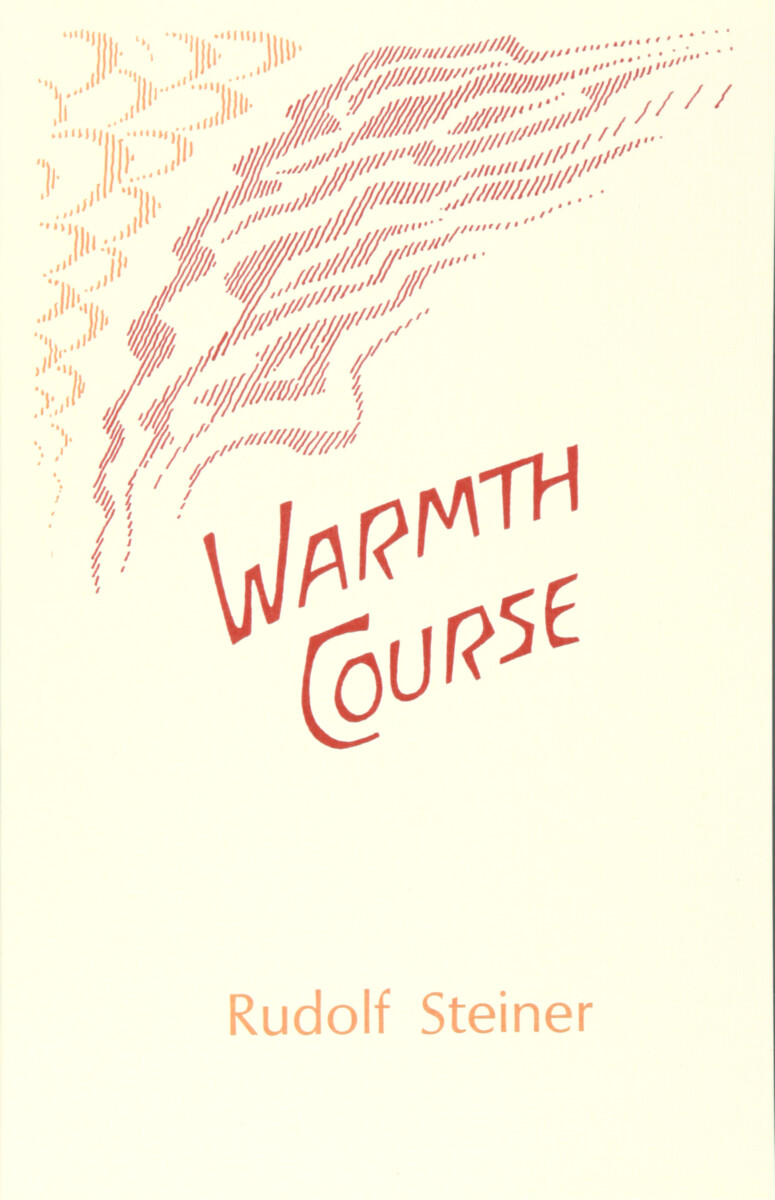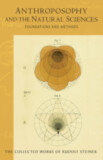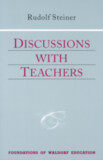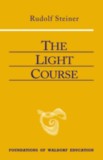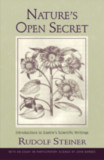Warmth Course
The Theory of Heat: Second Scientific Lecture Course (CW 321)
- Publisher
Mercury Press - Published
5th June 1995 - ISBN 9781957569000
- Language English
- Pages 214 pp.
- Size 5.5" x 8"
The Theory of Heat; Second Scientific Course;
14 lectures, Stuttgart, March 1–14, 1920 (CW 321)
Following his first scientific course the previous year (The Light Course), in these lectures Rudolf Steiner discusses the nature of warmth, its relationship to the four states of matter, to light, to color, and to the subearthly and superearthly realms. He extends the modern ideas of physics through aspects of understanding achieved by spiritual science. With extensive notes and diagrams, this work comprises essential reference material for natural science teachers, as well as interested parents and anyone wanting a deeper understanding of a theory of heat and warmth based on spiriual science.
“The manifold new aspects of the subject presented placed the element of warmth within the great evolution of the cosmos and then traced it even into the phenomena of life, the concrete processes in the transformation of the states of aggregation in matter, and even into mathematical formulae.... Indications thus given were then worked out during the following years in the Research Institute and Laboratory at the Goetheanum and traced into numerous phenomena of the rhythms of the day and the year, phenomena of life, the most subtle influences in processes of crystallization, and they became useful in the later inaugurated agricultural work.” —Guenther Wachsmuth, The Life and Work of Rudolf Steiner (p. 378)
This volume is a translation from German of Geisteswissenschaftliche Impulse II zur Entwickelung der Physik II: Zweiter naturwissenschaftlicher Kurs: Die Wärme auf der Grenze positiver und negativer Materialität (GA 321).
C O N T E N T S:
Introduction
1. March 1, 1920: Sensation of warmth and the thermometer. Achilles and the turtle. The Tragedy of thinking removed from perception. Atomism. Cosmic theories. Constitution of the sun—negative mater. Contrast between seeing colors and the sensation of warmth. Mechanical theory of heat. The irreversibility of organic and large inorganic processes—integration and differentiation in relation to reality.
2. March 2, 1920: Warmth expansion in one, two, and three dimensions. Ignoring higher potencies cancels out essentials. Individual coefficient of expansion of solid bodies and uniform expansion of gaseous bodies as symptoms. Accademia del Cimento at the transition to a more modern physics. A multitude of detailed observations compared with impoverished concepts. The irregular behavior of water. Cosmic forces in Greek physics and their later displacement into atoms.
3. March 3, 1920: Cessation of temperature rise during melting and boiling. Disappearance of points into a higher dimension. Goethean physics. Temperature as fourth dimension for Crookes. Individual form of the solid body, pressure of the gas.
4. March 4, 1920: Relationship of pressure and volume in gases. The nature of warmth in connection to mechanical facts. The departure from three-dimensional space. The judgment—warmth transforms itself into work. Isolated sense organs for light and tone; the entire human being as a sense organ for warmth and pressure. Conscious, passive concepts filtered out of perceptions of the higher senses. Imperceptibility of the will as one proceeds inward and imperceptibility of electricity as one proceeds outward.
5. March 5, 1920: Higher concepts and sense perception; mathematical concepts and will. Bridging dualism. Memorizing a poem. Abstract thinking and imaginative thinking. Knowledge of space and time on the one hand and knowledge of mass on the other. Kant. Individual form of solid bodies and the surface level of fluids. Gas and cosmos. Water as the cardinal exception.
6. March 6, 1920: Steam pressure. Melting of ice under pressure. Lowering of melting point in an alloy. Lines of fall of solid bodies and their surface levels—in liquids these are materially present. Solid bodies as picture of the fluid—fluid as picture of the gas—gas as picture of warmth.
7. March 7, 1920: Melting of ice under pressure as picture of air. Discarding essentiality from the concepts of modern natural science. Eduard von Hartmann. The significance of new research institutes. Heating water by work. Solid planet—gravity. Aeriform planet—negative gravity. Fluid planet—null sphere. Polyhedral structure, negative form spere, or null sphere. Relations to solid, gaseous fluid. Warmth night and warmth day.
8. March 8, 1920: Steam engine. Transformation of heat into work and the reverse. The two axioms of the theory of heat in Eduard von Hartmann. J.R. Mayer. The dispute over a “closed system” in the solid body. Schema of body states—shape in solid. Densification and rarefaction and between becoming material and becoming spiritual. The ordinary spectrum and Goethe’s closed color circle. Comparison with the schema of the body states.
9. March 9, 1920: Water wheel and steam engine. Achievement based on differences of levels. Approaching the human being with physical phenomena. The path of J.R. Mayer. The relations of corporeality—one has its image in the other. Polarization figures. Densification–rarefaction and tone. Rainbow and secondary rainbow. In the usual spectrum something remains in the unknown. Earth rotation in relation to the physical realms.
10. March 10, 1920: Separation of heat effects from a light cylinder through alum. Passage of warmth through an ice lens. Warmth conduction. The conditions of corporeality and the human being. Structural force—conception. Warmth—will. Negative matter in the human being. Suction effect vs. pressure effect.
11. March 11, 1920: The red, blue, and green of the spectrum. Separation of heat effects by alum. Separation of chemical effects by aesculin. Separation of light effects by iodine. The ordinary spectrum as a result of earthly forces. Comparison with the effects of a magnet. Darkening—illumination. Materialization—dematerialization. Warmth as intensive movement instead of extensive movement of atoms. Will and concepts. Warmth at the border of pressure and suction effects. E. Mach concerning the limits of the energy law. Warmth as physical-spiritual vortex.
12. March 12, 1920: Transparency. Warmth conduction equation. Expansion of the corresponding effects of the various parts of the spectrum. Positive, negative, imaginary numbers. Super-imaginary numbers and bending the spectrum. Life’s place in relation to inorganic nature.
13. March 13, 1920: Experiment with alum, iodine, aesculin. Warmth works in gas—light passes through without participation—image of image. Chemical effects in the liquid. Life effects in the solid are absent. Warmth as state of balance between the etheric and the ponderable-material. Physics of the past and the future. Null sphere as spatial border of contemporary physics. Entropy.
14. March 14, 1920: Effects are pure in the spectrum chemical effect—chemical processes. Chemical effect—sound effects. Taking hold of the effect by the earth in one case, by the peripheral working in the other case. Ponderable and imponderable effects. Differences of level within one realm of reality and between different realms tone perception. Filling space—emptying space. Earth and planets. Cosmic effects are displaced into atoms. Tearing apart space—lightning. Abstract concepts—thinking in accord with reality. Public schools, preparatory schools, technology schools. Embryology considered microscopically from the viewpoint of its cosmic starting points.
Notes
Rudolf Steiner
Rudolf Steiner (b. Rudolf Joseph Lorenz Steiner, 1861–1925) was born in the small village of Kraljevec, Austro-Hungarian Empire (now in Croatia), where he grew up. As a young man, he lived in Weimar and Berlin, where he became a well-published scientific, literary, and philosophical scholar, known especially for his work with Goethe’s scientific writings. Steiner termed his spiritual philosophy anthroposophy, meaning “wisdom of the human being.” As an exceptionally developed seer, he based his work on direct knowledge and perception of spiritual dimensions. He initiated a modern, universal “spiritual science” that is accessible to anyone willing to exercise clear and unbiased thinking. From his spiritual investigations, Steiner provided suggestions for the renewal of numerous activities, including education (general and for special needs), agriculture, medicine, economics, architecture, science, philosophy, Christianity, and the arts. There are currently thousands of schools, clinics, farms, and initiatives in other fields that involve practical work based on the principles Steiner developed. His many published works feature his research into the spiritual nature of human beings, the evolution of the world and humanity, and methods for personal development. He wrote some thirty books and delivered more than six thousand lectures throughout much of Europe. In 1924, Steiner founded the General Anthroposophical Society, which today has branches around the world.


